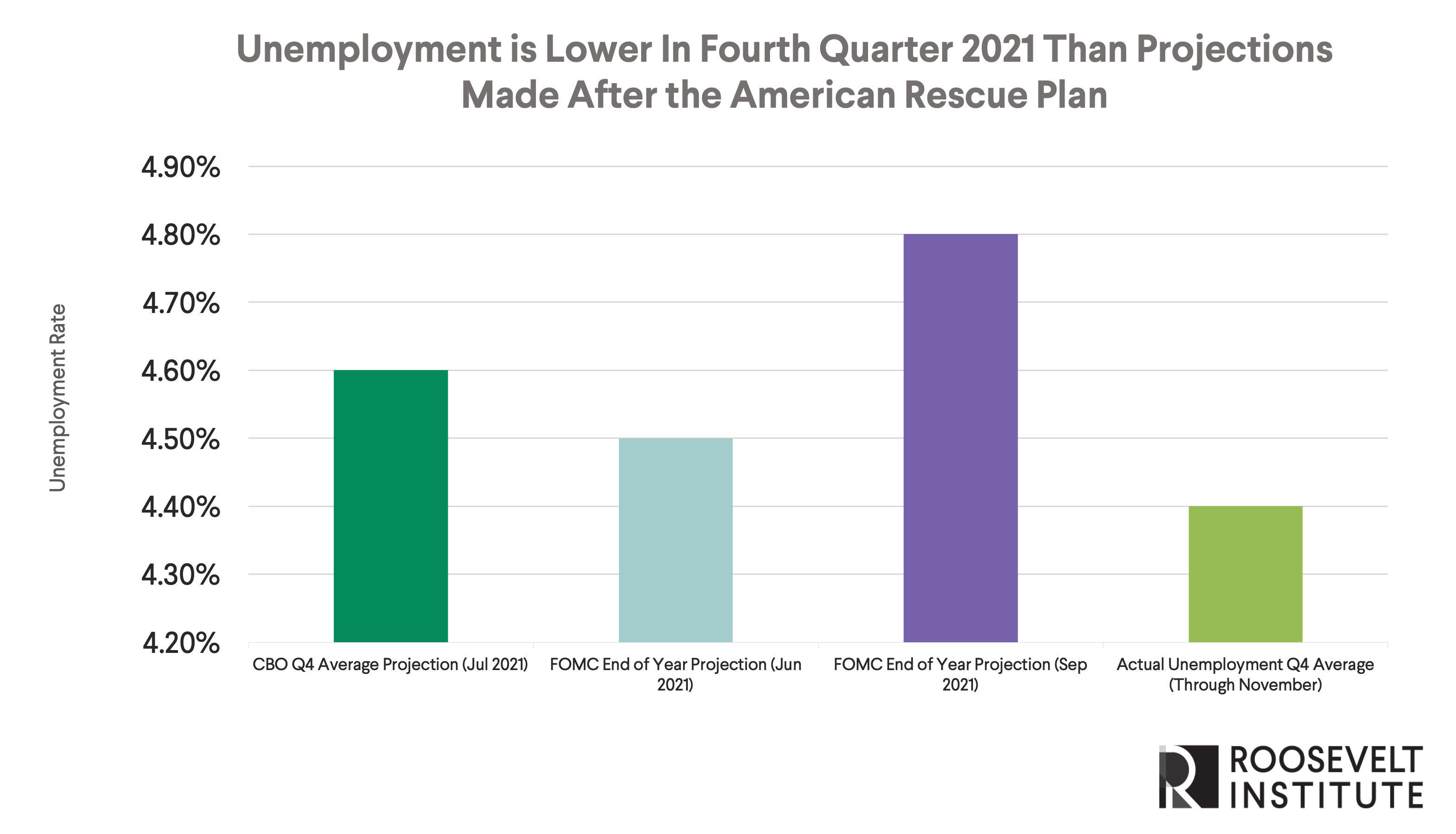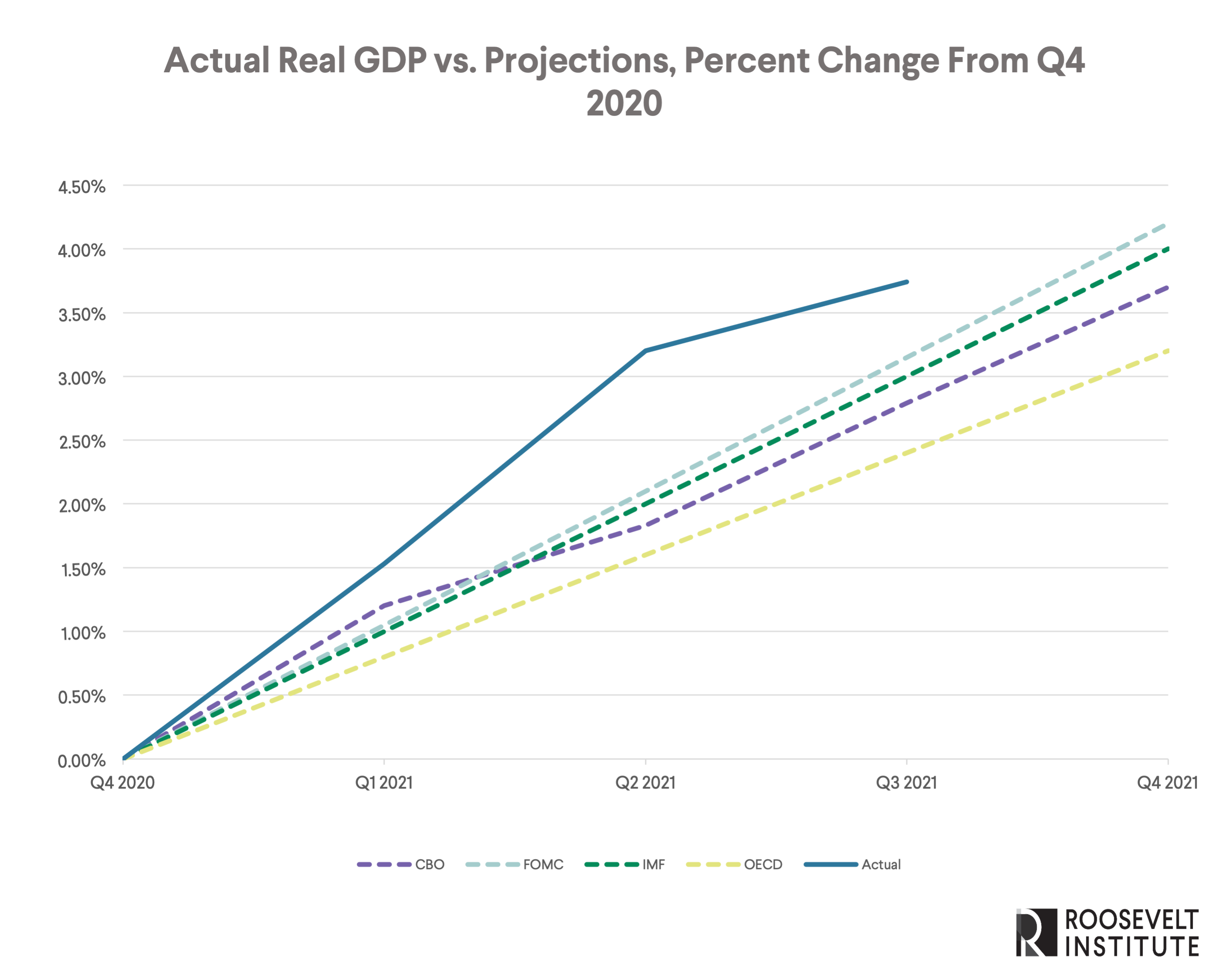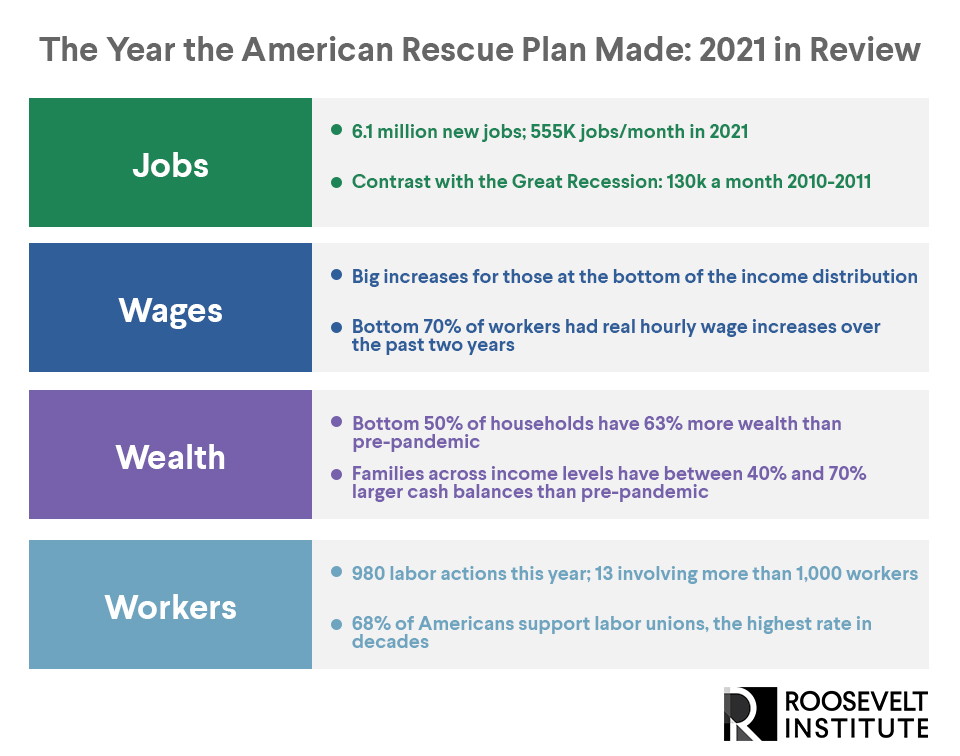The Year the American Rescue Plan Made: 2021 in Review
December 9, 2021
By Mike Konczal, Emily DiVito
The economic response to the pandemic will be studied for decades. As the year comes to a close, it’s important that the first draft of this history documents the successes of the policy responses to the pandemic, and especially the choice to make full employment a serious policy goal. As a result of this choice, there are many achievements to celebrate, from millions more jobs and higher wages to greater economic security and increased worker power. And even better, we avoided the worst-case alternative: the weaker, slower recovery that was projected if the American Rescue Plan (ARP) had not passed, and deeper harm to those who’ve historically been left behind by past recoveries.
That’s not to downplay the serious challenges that still exist in this recovery. Due in large part to COVID-induced disruptions and supply chain pressures, inflation has turned out to be higher than anyone had forecasted. We are still millions of jobs away from where we would be at full employment. This disproportionately burdens Black and brown communities who, because of the legacy of racist economic institutions and practices, generally have an unemployment rate double that of white communities. Mothers and other caregivers are still juggling unsustainable workloads. These are important concerns that need policy responses. Yet the economic conditions we face are also better than what anyone expected at the beginning of this year.
These successes far exceed the straightforward goal of the ARP, which was, as Treasury Secretary Janet Yellen testified in March 2021, “With the passage of the Rescue Plan [. . .] we may see a return to full employment next year.” We can see this in two ways. The first is to look at the strong headline numbers across many parts of the economy. Second, we can compare these to what we avoided—all the projections that were beaten as a result of the ARP.
The Year That Was
The first success is the number of jobs created. Through November, the US has added an average of 555,000 jobs per month, for a total of 6.1 million new jobs in 2021. For comparison, that eclipses monthly job growth after the Great Recession, which averaged just 130,000 jobs a month from 2010 to 2011. Even as the Delta variant raged, the US added an average of 405,000 jobs a month from August to November 2021. You may not realize this from the media coverage, because these numbers have been revised up 976,000 jobs throughout the year versus their initial reporting. Exact comparisons are tough, but we can clock this recovery, as Niskanen Center’s Matt Darling does, at eight times the speed of the Great Recession.
This success also extends to wages. Wages are increasing for those who’ve historically been left behind during past recoveries. Using the Atlanta Fed’s Wage Growth Tracker, we see younger workers (16-24 years old) saw a 9.7 percent wage increase, and the bottom 25 percent of earners saw a 5.1 percent raise. Workers with a high-school education and those at the bottom of the income distribution all saw wage growth stronger than average for recovery periods. This is still true when you account for the effects of inflation. Multiple sources find that around the bottom 70 percent of workers had real hourly wage increases over the past two years.
Another achievement: Families are now more economically secure. Because of the American Rescue Plan and other investments, the bottom 50 percent of households now have more than $3 trillion in wealth—that’s up nearly 20 percent from early 2021, and up 63 percent from pre-pandemic levels. In September 2021, families’ cash balances were between 40 and 70 percent higher than they were pre-pandemic. This is true for families at all income levels, but especially so for low-income families and those with children receiving the ARP’s Child Tax Credit (CTC). As researchers describe, these extra savings are “a substantial increase but by no means a thick security blanket for low-income families.” While these increased savings are not sufficient to eliminate the poverty our economic institutions create, they have afforded families a financial cushion to help weather this pandemic and recovery.
This, in turn, creates the conditions for another accomplishment: American workers now feel secure enough to find new jobs and also demand better wages and working conditions. The hiring and quit rates were at record highs this year, while the rate of people moving straight from one job to another is at its pre-pandemic level. This is important for both workers and the economy as a whole, because job switching allows workers to find better matches for their skills, a key driver of wage increases and long-term growth.
This increased economic security is also promoting worker activism. Strikes and solidarity actions are on the rise around the country. So far this year, there have been 980 strikes and labor protests across industries. Thirteen have involved more than 1,000 workers, contrasted with an average of only eight per year from 2009 to 2010 following the Great Recession. And tens of thousands more gig workers, fast-food workers, and coffeehouse workers not covered under union contracts are protesting and taking collective actions to improve their workplaces and conditions. Voters are increasingly supportive of these actions, with 68 percent of Americans approving of labor unions, the highest rate since 1965.
The Year That Was Prevented
But it’s also worth looking at the year that was prevented, the weaker recovery that would have happened without the ARP. At the beginning of this year there were several projections of the recovery minus any additional spending. Though these calculations were from multiple agencies, each with their own methodologies, they all tell the same story: The recovery would have been much slower this year and stalled significantly next year. Instead, we are on track for a full recovery to pre-pandemic levels in 2022.
On February 11, 2021—exactly one month before the ARP was signed into law—the Congressional Budget Office (CBO) projected that we would end 2021 with an unemployment rate of 5.3 percent (averaged across the fourth quarter). Worse, the recovery would slow dramatically, with unemployment of 4.9 percent at the end of 2022 and 4.2 percent at the end of 2024. At the time, we wrote that the CBO was “disturbingly complacent about a forecast that the economy will not reach what they consider full employment and potential output until 2025” and “that the economy is still in need of major stimulus.”
But it wasn’t just the CBO. In December 2020, the Federal Reserve’s Federal Open Market Committee (FOMC) projected that the US would end 2021 with an unemployment rate of 5 percent. Worse, unemployment would be at 4.2 percent at the end of 2022. Though more optimistic than the CBO’s numbers, it still shows the slowdown that would have happened well before we got to pre-pandemic employment levels. Instead, as Figure 1 shows, the unemployment rate fell much faster after the ARP passed.
Authors’ calculations from data at the CBO and the BLS.
Even though we only have numbers for November, with unemployment already at 4.2 percent, that’s 1.5 million more jobs than the CBO predicted without the ARP and 1.3 million more jobs than the FOMC.
But it’s not just the comparison with pre-ARP predictions that illustrates how strong this recovery has been. The unemployment number has also beat expectations that were set even after the ARP passed. During the summer, both the CBO (in July) and the FOMC (in June and September) made new predictions of where unemployment would end the year. In July 2021, the CBO predicted that the US would close out the year with an unemployment rate of 4.6 percent. The FOMC, predicted in June and September 2021 that year-end unemployment would be 4.5 percent and 4.8 percent, respectively, reflecting the optimism of the summer’s early vaccinations and the pessimism of the fall’s Delta wave. As Figure 2 shows, the actual number beat these as well.

Also note the impact of these new estimates at the end of 2022. After the ARP, the CBO moved their estimate of Q4 2022 unemployment from 4.9 percent to 3.6 percent. That’s 2.2 million more jobs at the end of next year than would have existed without it. Though just estimates, and subject to the uncertainty of this next year, it is a far more positive path for the recovery than what we would have faced without the ARP.
This same dynamic is true of GDP growth. In February 2021, the CBO predicted that the US would see year-over-year real GDP growth of 3.7 percent. In December 2020, the FOMC predicted real GDP growth of 4.2 percent in 2021. These are similar to pre-ARP estimates for the United States from the IMF (4 percent) and the OECD (3.2 percent). As Figure 3 shows, and many others have pointed out, the United States is easily beating these estimates.

Among peer countries, the US is not only having the strongest recovery, but the largest upward revisions to projected GDP growth. In October 2020, the IMF projected real GDP growth across countries for 2021–2022, and then updated those projections in October 2021. Figure 4 shows the projections for real GDP growth from before the pandemic through next year, and as we can see, the forecast for the United States stands out—a direct result of the ARP.

This in no way minimizes the real challenges we face. We must continue to get COVID under control and address the potential threat of new variants. The shift in spending from services to goods has overwhelmed our supply chains and led to surprising inflation. More research is needed to understand how inflation will evolve next year. But until this recovery gets beyond pre-pandemic levels of employment, especially for Black and brown communities, we must stay on the path to a full recovery.
Amid these challenges, it’s easy to take the successes so far for granted. But these hard-fought political victories deserve a central place in the story of this recovery. Everything, from rapid job growth on down, was a choice based on prioritizing full employment. That was the right decision.



